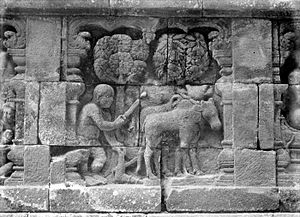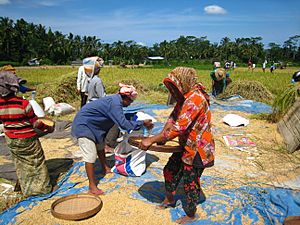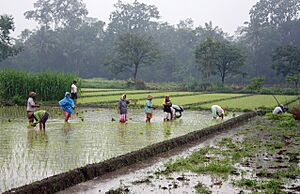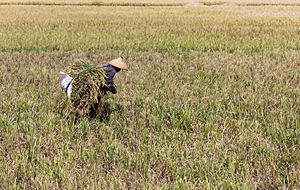Rice production in Indonesia facts for kids
Rice production in Indonesia is super important for the country's economy. In fact, Indonesia is one of the top three rice producers in the whole world!
Rice is the main food for most people in Indonesia. It provides more than half of the daily calories for an average person. Back in the 1980s, about 20 million families, or 100 million people, depended on rice farming for their living. Rice farms covered about 10 million hectares across Indonesia. Most of these farms were "sawah," which are wet rice fields. Having enough water is key for growing lots of rice, especially with special high-yield seeds. In 1987, about 58% of rice farms had irrigation systems. Another 20% relied on rain, and the rest grew rice on dry land or in swamps.
Contents
History of Rice in Indonesia

Rice is a very important food for everyone in modern Indonesia. It's a big part of Indonesian culture and Indonesian cuisine. Rice farming even shapes the landscape! You'll find rice sold everywhere, and it's served in most meals. It can be a savory dish or even a sweet treat.
The importance of rice is clear in Indonesian culture. People traditionally honored Dewi Sri, who is the rice goddess of ancient Java and Bali. Farmers celebrated the rice growing seasons with special events. For example, the Sundanese have a rice harvest festival called Seren Taun. In Bali, farmers created a special water system called subak to make sure rice fields got enough water. Priests managed these systems, which were often connected to "water temples."
How Indonesians Eat Rice
Most often, rice is eaten plain with different side dishes like vegetables and meat. But rice is also used to make many other delicious foods:
- Nasi uduk: Rice cooked in coconut milk.
- Nasi kuning: Rice cooked with coconut milk and turmeric (which makes it yellow!).
- Ketupat: Rice steamed inside woven coconut leaf packets.
- Lontong: Rice steamed in banana leaves.
- Intip or rengginang: Crunchy rice crackers.
- Desserts made from rice.
- Vermicelli and noodles.
- Arak beras: A type of rice wine.
- Nasi goreng: Fried rice. This dish is found everywhere in Indonesia and is considered a national dish.
Early Rice Farming
Scientists have found signs of wild rice on the island of Sulawesi from as far back as 3000 BC. But the first signs of people actually growing rice come from stone carvings in central Java from the 8th century. These carvings show that kings collected taxes in rice!
You can also see pictures of rice farming on the Karmawibhangga carvings at Borobudur temple. These carvings show rice barns and even mice causing problems in the fields. The 9th-century Prambanan temples in Central Java also have carvings that show how people worked together to grow rice. They show a water buffalo pulling a plow, women planting seedlings and pounding rice, and a man carrying rice bundles on a pole across his shoulders.
When Europeans visited Indonesia in the 16th century, they saw rice as a special food. It was served to important people during ceremonies and big parties.
Tools and Animals for Rice Farming
Growing rice in Indonesia's history is connected to two important things:
- The development of iron tools.
- Taming wild water buffalo to become water buffalo. These animals helped farmers plow fields and provided manure to make the soil richer.
Rice plants need lots of sunshine to grow well. Over the last 1,500 years, much of Indonesia's thick forests have been slowly cleared. This made space for permanent fields and villages as rice farming grew.
Rice Supply and Trade
| Year | Production (in tonne) | Import (in tonne) |
|---|---|---|
| 1955 |
14,432,000
|
127,000
|
| 1960 |
16,860,000
|
966,000
|
| 1961 |
12,084,000
|
1,063,760
|
| 1962 |
13,004,000
|
1,096,050
|
| 1963 |
11,595,000
|
1,075,310
|
| 1964 |
12,306,000
|
1,024,450
|
| 1965 |
12,975,000
|
193,000
|
| 1966 |
13,650,000
|
306,000
|
| 1967 |
13,222,000
|
346,600
|
| 1968 |
17,162,800
|
485,900
|
| 1969 |
18,020,200
|
604,600
|
| 1970 |
19,331,000
|
956,130
|
| 1971 |
20,190,000
|
506,000
|
| 1972 |
19,393,600
|
734,300
|
| 1973 |
21,489,500
|
1,862,690
|
| 1974 |
22,473,010
|
1,132,070
|
| 1975 |
22,339,200
|
691,780
|
| 1976 |
23,300,940
|
1,301,180
|
| 1977 |
23,347,140
|
1,973,360
|
| 1978 |
25,771,600
|
1,841,580
|
| 1979 |
26,282,660
|
1,922,030
|
| 1980 |
29,651,900
|
2,011,710
|
| 1981 |
32,774,180
|
538,280
|
| 1982 |
33,583,700
|
309,640
|
| 1983 |
35,303,010
|
1,168,480
|
| 1984 |
38,136,450
|
414,330
|
| 1985 |
39,032,940
|
33,830
|
| 1986 |
39,726,770
|
27,760
|
| 1987 |
40,078,190
|
54,980
|
| {{{label30}}} |
41,676,180
|
32,730
|
| Year | Production (in tonne) | Import (in tonne) |
|---|---|---|
| 1989 |
44,725,580
|
268,200
|
| 1990 |
45,178,750
|
49,390
|
| 1991 |
44,688,240
|
170,970
|
| 1992 |
48,240,010
|
609,560
|
| 1993 |
48,129,321
|
23,780
|
| 1994 |
46,598,380
|
629,860
|
| 1995 |
49,697,444
|
3,154,910
|
| 1996 |
51,048,899
|
2,147,780
|
| 1997 |
49,339,086
|
329,310
|
| 1998 |
49,236,692
|
2,891,680
|
| 1999 |
50,866,000
|
4,671,220
|
| 2000 |
51,899,000
|
1,338,990
|
| 2001 |
50,461,000
|
639,540
|
| 2002 |
51,490,000
|
1,790,320
|
| 2003 |
52,137,000
|
1,613,420
|
| 2004 |
54,088,000
|
700,000
|
| 2005 |
54,200,000
|
600,000
|
| 2006 |
54,500,000
|
700,000
|
| 2007 |
57,200,000
|
1,800,000
|
| 2008 |
60,300,000
|
300,000
|
| 2009 |
64,400,000
|
300,000
|
| 2010 |
66,500,000
|
1,000,000
|
| 2011 |
65,800,000
|
2,900,000
|
| 2012 |
69,100,000
|
1,800,000
|
| 2013 |
71,300,000
|
700,000
|
| 2014 |
70,800,000
|
1,000,000
|
| 2015 |
73,000,000
|
1,300,000
|
| 2016 |
72,600,000
|
1,300,000
|
| 2017 |
73,900,000(Estimate)
|
400,000(Estimate)
|
| 2018 |
74,500,000(Forecast)
|
1,500,000(Forecast)
|


The Indonesian government has always been very involved in the rice business. They wanted to keep rice prices stable for people in cities. They also wanted Indonesia to grow enough rice for itself, so it wouldn't have to buy much from other countries.
How the Government Helped Rice Farming
The government used several ways to help rice production:
- They shared special high-yield rice seeds with farmers.
- They invested money to build and fix irrigation systems.
- They controlled the price of rice through a special organization called the National Logistical Supply Organization (Bulog).
In the 1970s, Indonesia bought a lot of rice from other countries. But by 1985, Indonesia was growing enough rice for its own needs! This happened after six years of great growth in rice production. From 1968 to 1989, the amount of rice grown each year jumped from 12 million tons to over 40 million tons. Also, the amount of rice harvested per field almost doubled.
New Seeds and Farming Methods
A big reason for this success was the use of high-yield rice seeds. By the mid-1980s, about 85% of rice farmers were using these special seeds. This was a huge jump from only 50% in 1975.
These high-yield seeds were promoted along with special programs. These programs offered farmers cheaper fertilizer, pesticides, and loans. They also taught farmers new ways to grow rice.
However, these new methods sometimes caused problems. For example, there were big outbreaks of a bug called the brown planthopper. This happened because the strong pesticides killed the bugs that naturally ate the planthoppers. So, in 1988, a new plan was started called "integrated pest management." This plan used different ways to control bugs, plant diseases, and rodents, so farmers didn't have to use as many pesticides. To help with this, the government stopped making pesticides cheaper in 1989.
Improving Irrigation
Government money also helped a lot with irrigation. From 1969 to 1989, about 2.5 million hectares of existing irrigated land were fixed up. Also, irrigation was added to about 1.2 million new hectares of land. This meant more rice fields had a steady water supply.
Keeping Prices Fair
Bulog, the government's rice organization, tried to keep rice prices fair for everyone. They wanted city people to be able to afford rice, but they also wanted farmers to earn enough money. Bulog managed a large amount of stored rice, like a "buffer stock" of about 2 million tons in the 1980s. If rice prices dropped too low, Bulog would buy rice from farmers. If prices went too high, Bulog would sell rice from its stores. This helped keep prices steady for both farmers and consumers.



